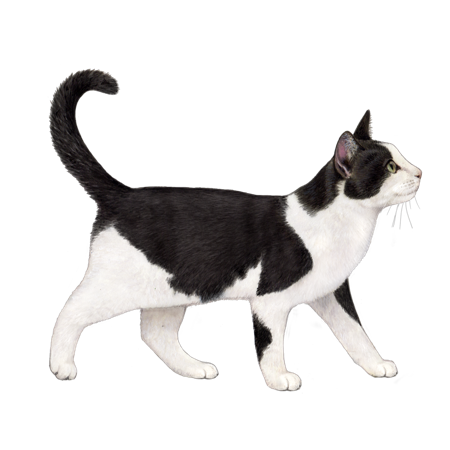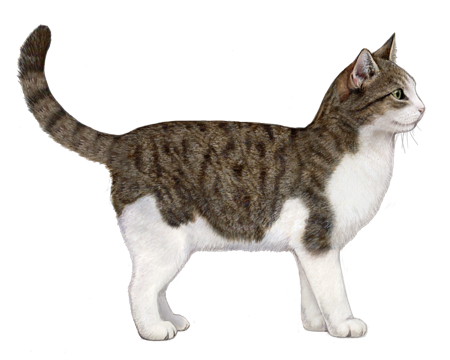
American Domestic Cat
American Domestic cats are a delightfully mixed bag of adorable features and personalities. No matter what you're looking for in a feline friend, there's undoubtedly a Domestic cat out there that will meet your criteria.
Interested in discovering if your cat is an American Domestic Cat?
Check out Wisdom Panel's DNA test.
American Domestic Cat Traits
General Appearance
Unlike other breeds recognized by their specific physical characteristics, Domestic cats come in a wide range of colors, sizes, and builds. Still, they’re typically medium-sized and muscular.
Coat and Colouring
The coat of a Domestic cat comes in all colors, patterns, and lengths. Any coat combination that's genetically possible is on the table for this breed.
Distinctive Physical Traits
Perhaps American Domestic cats' most distinctive physical trait is their uniqueness. There are no hard and fast rules for these cats, which means the average Domestic may display any number of adorable features.
American Domestic Cat Temperament
As with their physical appearance, American Domestic cats' personalities vary. Some cats are chatty and like to be the life of the party, while others make for quiet, calm, lap cats. And some prefer to interact with their humans on an "as needed" basis—these are the most independent and aloof of the bunch.
Because of their background as barn cats and rodent catchers, American Domestics are typically athletic and agile, with strong hunting instincts. Using feather toys and other items they can pounce on or chase gives them a much-needed outlet for their natural tendencies.
Domestics also tend to enjoy keeping an eye on the outside world. High perches where they can safely look out at birds and other wildlife will keep them entertained for hours.
American Domestic Cat History
Domestic cats are arguably the most familiar of all the cat breeds—and certainly the most common. In fact, people actually refer to them as "common cats," as well as housecats and alleycats. The result of random-bred cats, they are the "mixed-breeds'' of the feline world.
The longhaired variety of the Domestic cat likely originated in Western Asia. They lived there for several centuries before being imported to Europe in the 16th century. In the 1700s, these cats departed on ships for the United States, where they worked—along with their shorthaired counterparts—as dedicated rodent catchers.
Early pioneers adored American Domestics for their work ethic and keen hunting skills. They provided these cats with shelter and food in exchange for keeping the barns and food storage areas free from vermin. It wasn't long before Domestics worked their way fully into their owners' lives. They graduated from the clean-up crew to beloved family members and have never looked back.
Though Domestics aren't pedigreed cats, some cat associations allow them to compete in shows in a general "housecat" category.
American Domestic Cat Care
Nutrition
Domestic cats require a high-quality diet. Because nutritional needs vary for kittens, adults, and senior cats, opt for a formula that's age-appropriate for your pet.
Obesity is a growing health concern for cats. To keep calories in check, portion out meals using a standard measuring cup, and reduce amounts if your cat gains weight. Also, keep an eye on how many treats you're giving them. As a guideline, treats should make up no more than 10% of a cat's daily calories.
In addition to their meals, make sure there's plenty of fresh, clean water available for your cat at all times.
Grooming
Though American Domestics are excellent self-groomers, they still need regular brushing to keep their coats looking their best. Shorthaired cats can usually get by with weekly brushing using a rubber or steel comb. Longhaired cats are more prone to tangles and mats and may require daily brushing.
In addition to combing, trim their claws monthly to prevent overgrowth. Nails that get too long are more likely to get snagged on something and become torn or damaged. Overgrown nails can also grow into their paw pads, leading to pain or infection. In addition to clipping, a scratching post will help keep their nails in good shape and satisfy their instinct to scratch.
Finally, all cats need regular dental care—including at-home teeth brushing and professional dental exams and cleanings.
Health
Roughly one out of every three cats in the United States is overweight or obese. Extra weight can contribute to other health risks, such as arthritis, diabetes, and heart problems. Your veterinarian is a great resource for tips on how to keep your cat at a healthy weight.
American Domestic Cat Genetic Health Conditions
-
Acute Intermittent Porphyria (Variant 1)
Acute Intermittent Porphyria (AIP) is caused by faulty enzyme activity and results in brownish discoloration of the teeth and urine in affected cats.
-
Acute Intermittent Porphyria (Variant 2)
Acute Intermittent Porphyria (AIP) is caused by faulty enzyme activity and results in brownish discoloration of the teeth and urine in affected cats.
-
Acute Intermittent Porphyria (Variant 5)
Acute Intermittent Porphyria (AIP) is caused by faulty enzyme activity and results in brownish discoloration of the teeth and urine in affected cats.
-
Congenital Adrenal Hyperplasia
Congenital Adrenal Hyperplasia is an endocrine disorder which leads to aggression, abnormalities of the genitalia, and excessive drinking and urination.
-
Congenital Erythropoietic Porphyria
Congenital Erythropoietic Porphyria (CEP) is caused by faulty enzyme activity and results in brownish discoloration of the teeth and urine in affected cats.
-
Cystinuria Type 1A
Cystinuria is a condition that predisposes cats to form cystine crystals and stones within the urinary tract, which can then cause irritation and blockage.
-
Cystinuria Type B (Variant 1)
Cystinuria is a condition that predisposes cats to form cystine crystals and stones within the urinary tract, which can then cause irritation and blockage.
-
Cystinuria Type B (Variant 2)
Cystinuria is a condition that predisposes cats to form cystine crystals and stones within the urinary tract, which can then cause irritation and blockage.
-
Cystinuria Type B (Variant 3)
Cystinuria is a condition that predisposes cats to form cystine crystals and stones within the urinary tract, which can then cause irritation and blockage.
-
Dihydropyrimidinase Deficiency
Dihydropyrimidinase Deficiency is a condition that causes tiredness, weakness, vomiting, and high levels of ammonia in the blood.
-
Earfold and Osteochondrodysplasia (Discovered in the Scottish Fold)
The Earfold and Osteochondrodysplasia variant results in the breed defining folded ears of Scottish Fold cats and is associated with skeletal malformations and arthritis.
-
Factor XII Deficiency (Variant 1)
Factor XII Deficiency, also known as Hageman trait, is an asymptomatic blood factor deficiency. While it does not cause an abnormal tendency to bleed, it can be observed as prolonged blood clotting times during certain laboratory screening tests.
-
Factor XII Deficiency (Variant 2)
Factor XII Deficiency, also known as Hageman trait, is an asymptomatic blood factor deficiency. While it does not cause an abnormal tendency to bleed, it can be observed as prolonged blood clotting times during certain laboratory screening tests.
-
Glutaric Aciduria Type II
Glutaric Aciduria Type II causes loss of appetite, vomiting and seizures in young cats.
-
GM1 Gangliosidosis
GM1 Gangliosidosis causes muscle tremors, uncoordinated movements, and blindness.
-
GM2 Gangliosidosis
GM2 Gangliosidosis causes muscle tremors, uncoordinated movements, difficulty eating, and blindness.
-
GM2 Gangliosidosis Type II (Discovered in Domestic Shorthair cats)
GM2 Gangliosidosis Type II causes muscle tremors, uncoordinated movements, difficulty eating, and blindness.
-
Hemophilia B (Variant 1)
Hemophilia B, or Factor IX Deficiency, is a blood clotting disorder that can result in tiredness, decreased appetite, fever, lameness, and prolonged bleeding times after injury, trauma or surgery.
-
Hemophilia B (Variant 2)
Hemophilia B, or Factor IX Deficiency, is a blood clotting disorder that can result in tiredness, decreased appetite, fever, lameness, and prolonged bleeding times after injury, trauma or surgery.
-
Hyperoxaluria Type II
Hyperoxaluria Type II is a kidney disorder leading to severe weakness and kidney failure in young cats.
-
Lipoprotein Lipase Deficiency
Lipoprotein Lipase Deficiency is a metabolic disorder that causes decreased body mass and reduced growth rates in affected kittens and can cause stillbirths in affected queens.
-
MDR1 Medication Sensitivity
MDR1 Medication Sensitivity is a disorder caused by a defect to a drug pumping protein that plays an important role in limiting drug absorption and distribution (particularly to the brain). Cats with the MDR1 variant may have severe adverse reactions to some commonly used medications.
-
Mucopolysaccharidosis Type I
Mucopolysaccharidosis Type I is a disorder causing failure to thrive, facial and other skeletal abnormalities, tremors, and clouding of the eyes.
-
Mucopolysaccharidosis Type VI
Mucopolysaccharidosis Type VI is a rare disorder causing dwarfism, degenerative joint disease, and clouding of the eyes.
-
Mucopolysaccharidosis Type VII (Variant 1)
Mucopolysaccharidosis Type VII is a disorder causing weakness, growth retardation, facial and other skeletal abnormalities, and clouding of the eyes.
-
Mucopolysaccharidosis Type VII (Variant 2)
Mucopolysaccharidosis Type VII is a disorder causing weakness, growth retardation, facial and other skeletal abnormalities, and clouding of the eyes.
-
Mucopolysaccharidosis Type VI Modifier
Mucopolysaccharidosis Type VI Modifier causes a mild degenerative joint disease, but only if one copy of Mucopolysaccharidosis Type VI is also present.
-
Myotonia Congenita
Myotonia Congenita is a condition that results in stiff movement and delayed relaxation of muscles after exercise.
-
Polycystic Kidney Disease (PKD)
Polycystic Kidney Disease (PKD) is the most common inherited disease in cats. The disease causes the formation of fluid-filled cysts in the kidneys that can lead to kidney failure.
-
Pyruvate Kinase Deficiency
Pyruvate Kinase (PK) Deficiency is a disorder that causes anemia due to the breakdown of red blood cells.
-
Sphingomyelinosis (Variant 1)
Sphingomyelinosis causes progressive incoordination and tremors, enlargement of the spleen and liver, and changes in the lungs.
-
Sphingomyelinosis (Variant 2)
Sphingomyelinosis causes progressive incoordination and tremors, enlargement of the spleen and liver, and changes in the lungs.
-
Vitamin D-Dependent Rickets
Vitamin D-Dependent Rickets results in skeletal abnormalities caused by low blood calcium levels.
With more than 45 health tests, Wisdom Panel™ Complete for Cats screens for these and other important genetic conditions—allowing you to better plan for your cat's lifelong care.
Breed Group
Western
The largest of breed groups, the Western Group is mainly comprised of cats developed in Europe and the Americas. Due to the complexity of feline genetic diversity, however, cat breeds from other regions may also be found associated with this group.
Resources
https://en.wikipedia.org/wiki/Domestic_long-haired_cat
https://vcahospitals.com/know-your-pet/cat-breeds/domestic-long-hair
https://www.hillspet.com/cat-care/cat-breeds/domestic-shorthair
http://www1.fifeweb.org/dnld/std/HCL-HCS.pdf
https://www.banfield.com/state-of-pet-health/obesity
Reviewed 23 February 2021 by Annette Louviere, DVM


























